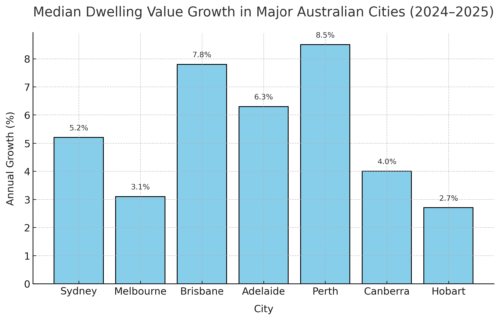Introduction
If you’re wondering how to build a diversified property portfolio in Australia, you’re in the right place. A well-diversified portfolio reduces risk, smooths returns and positions you for long-term wealth creation in the Australian property market. In this guide we’ll explore why diversification matters, show you the key strategies you should be using, and give you practical steps to apply today. Our thesis: by spreading investments across property types, locations and entry strategies, and managing finance and tax smartly, you can build a resilient property portfolio designed for growth and stability.
Why Diversification Matters in the Australian Property Market
Diversification in property means more than simply owning more than one investment. In the Australian context it means spreading across property types, locations, and risk profiles. According to industry commentary, diversification helps investors “balance risk and income” and “tap into growth from different markets”.
For the Australian investor, diversification offers several tangible benefits:
- If one local market softens (say one city), others may still perform.
- Different property types (residential, commercial, industrial) have different risk/return characteristics.
- Income streams from rental yield, capital growth and even alternative vehicles (eg property funds) help smooth returns.
In short, the strategy is especially relevant now: the Australian median dwelling value is rising but growth is moderated by affordability pressures.

Graph of median dwelling values growth in major Australian cities 2024-2025.
Key Strategies for Property Portfolio Diversification in Australia
Here we map secondary keywords into actionable strategies:
- Diversified property investment strategies Australia
Adopt a mix of strategies: e.g., high-yield properties to cover cash flow, capital-growth properties in growth corridors, and opportunistic value-add or niche investments. Experts note that “true diversification is far more nuanced” than simply buying many properties. - Property portfolio diversification Australia property types
Spread across types:- Residential houses for long-term capital growth.
- Apartments for easier entry and higher rental yields in metro areas.
- Commercial or industrial properties for alternative income streams (if capital allows).
- Regional vs metropolitan — geographic diversification prevents localised downturns. In Australia, this is important given economic, demographic and infrastructure differences across states/territories.
- Use equity from existing properties to fund the next acquisition, diversify loan structures and ensure you don’t have all properties leveraged in the same cycle. Managing the timing of market entry matters. The checklist from one Australian guide emphasises goals, strategy, research and long-term mindset.
How to Grow Your Property Portfolio in Australia in 2025 (and Beyond)
In 2025 Australia’s property market is shaped by several dynamics. For example, capital flows into commercial real estate were up 13 % y-o-y in H1 2025 to AUD $15.5 billion.
To grow effectively:
- Set clear investment goals: Is your focus income now, capital growth later, or balanced?
- Pre-approval for finance matters: The stronger your borrowing capacity, the quicker you can act when opportunities arise.
- Leverage rental income and build equity: Reinvest profits to expand your portfolio.
- Monitor market cycles and local factors: Property markets in Australia are heterogeneous, what performs in Brisbane may differ from Perth or regional NSW. Understanding vacancy rates, rental yields and demand-supply imbalances is key.
For example, if the national median dwelling value was up ~4.1 % in one year, but with underlying rental markets tightening, then there’s potential upside for well-selected properties. Global Property Guide
Managing Risk and Choosing the Right Property Types & Locations
Addressing common concerns and questions:
- What if interest rates rise? Diversification across property types and locations helps, and ensure you budget for higher debt servicing.
- What about regional vs metro? Regional locations may offer affordability, but may carry different risks (e.g., tenant supply, infrastructure).
- How to choose property types? The investor should match type to goal: e.g., apartments for yield, houses for growth. One Australian analyst notes houses “typically demonstrate stronger land value appreciation” while apartments may be easier to manage.
Also, geographic diversification means you’re not overly exposed to a downturn in one city or suburb. For example, analysts emphasise how property can provide stability and income as part of a diversified investment portfolio.
Tax, Finance and Practical Considerations for Australian Investors
To build a diversified portfolio you also need to understand the practical realities:
- Tax considerations: Property investors in Australia can access deductions (interest, maintenance, depreciation) but legislation and rules (eg negative gearing, capital gains tax) may change.
- Finance strategies: Rather than identical loan structures for all properties, consider variety (fixed vs variable, offset account, etc.).
- Professional advice: As always, this content is general in nature and not personal financial advice. You should seek independent advice from a qualified accountant, tax agent or financial adviser. Many Australian sources remind readers of this.
- Ongoing management: A diversified portfolio may mean multiple managers, locations, types. You must stay organised, track performance and be ready to review strategy.
Conclusion
Building a diversified property portfolio in Australia takes time, discipline and strategic thinking. We’ve covered why diversification matters, key strategies to implement it, how to grow your portfolio in 2025, how to manage risk and the practical financial and tax considerations involved. If you take one thing away it’s this: by spreading your investments across property types, locations and strategies, and by actively managing finance, tax and market dynamics, you set yourself up for greater resilience and better long-term outcomes.
Ready to take the next step? Contact our team for a tailored review of your investment strategy and map your property portfolio diversification plan.
_______________________________________________________________________
External Links:
- Building a Diverse Property Portfolio for Long-term Success
- Building a Diversified Investment Property Portfolio
- Australia’s Residential Property Market Analysis 2025
- Steps to Building a Diversified Property Portfolio
- How to Build a Property Portfolio – A Complete Guide
- Australian Capital Flows Report – H1 2025
- The Investor’s Guide to Australian Property Data: What Really Matters
- How Does Australian Property Fit Into A Diversified Investment Portfolio?
- How to Build and Manage a Diverse Property Portfolio in Australia






